Case Study: Management of Asthma and Pregnancy in Mrs. Najah's Case
VerifiedAdded on 2020/05/16
|17
|4251
|56
Case Study
AI Summary
This case study presents the scenario of Mrs. Najah, a 32-year-old pregnant woman admitted to the emergency room with severe breathing difficulties due to bronchial asthma. The study, conducted by a nursing student, details Mrs. Najah's medical history, including her asthma diagnosis since age 12, two previous abortions due to protein S deficiency, and current pregnancy. It analyzes both subjective data, such as her symptoms of coughing and wheezing, and objective data, including vital signs like elevated heart rate, respiratory rate, and low oxygen saturation. The case study outlines a nursing plan that involves assessing her breathing patterns, diagnosing ineffective breathing, and implementing interventions like administering bronchodilators and monitoring vital signs. The expected outcome is improved breathing patterns and normalized oxygen saturation levels. The study also addresses the patient's lifestyle and functional health patterns, providing a comprehensive view of her condition and the care provided.
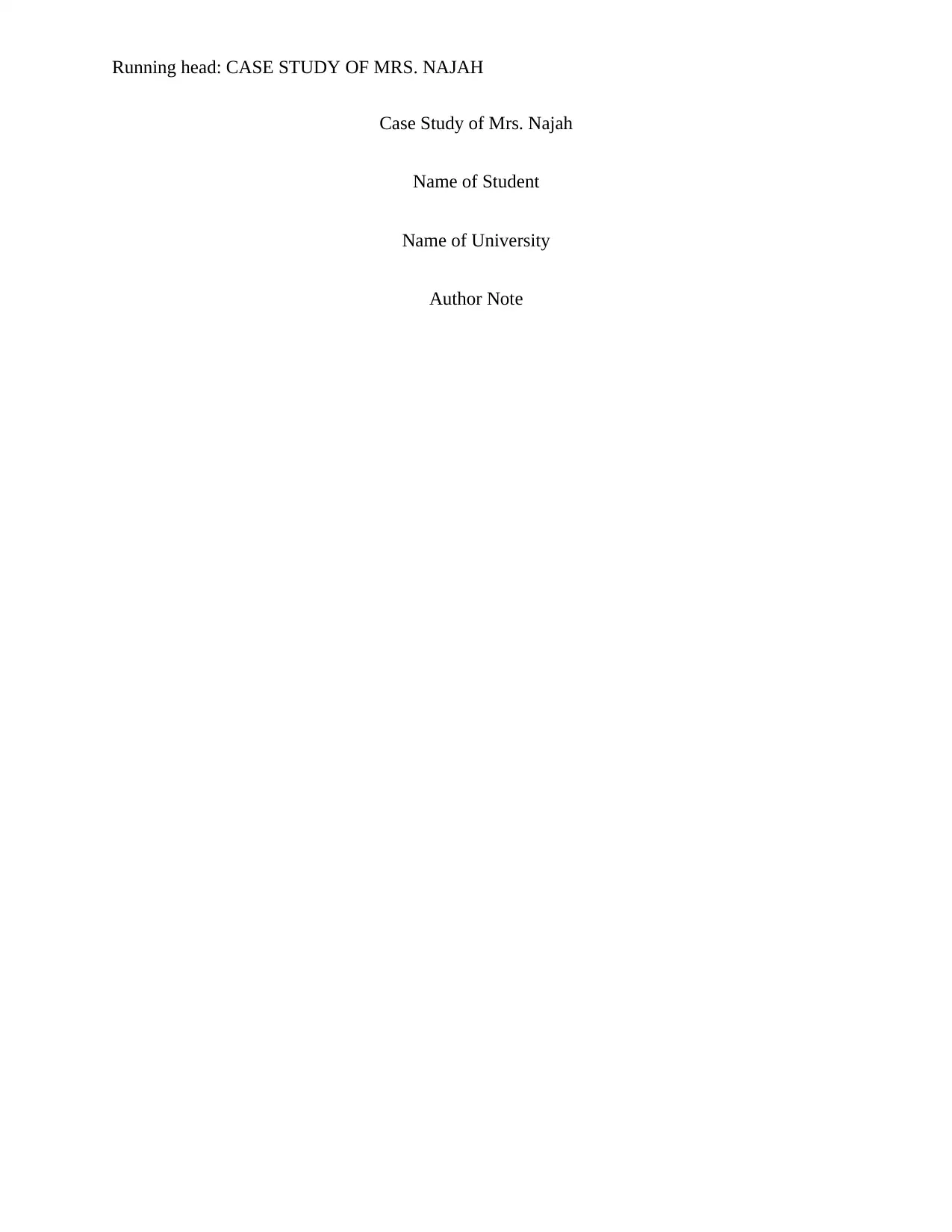
Running head: CASE STUDY OF MRS. NAJAH
Case Study of Mrs. Najah
Name of Student
Name of University
Author Note
Case Study of Mrs. Najah
Name of Student
Name of University
Author Note
Paraphrase This Document
Need a fresh take? Get an instant paraphrase of this document with our AI Paraphraser
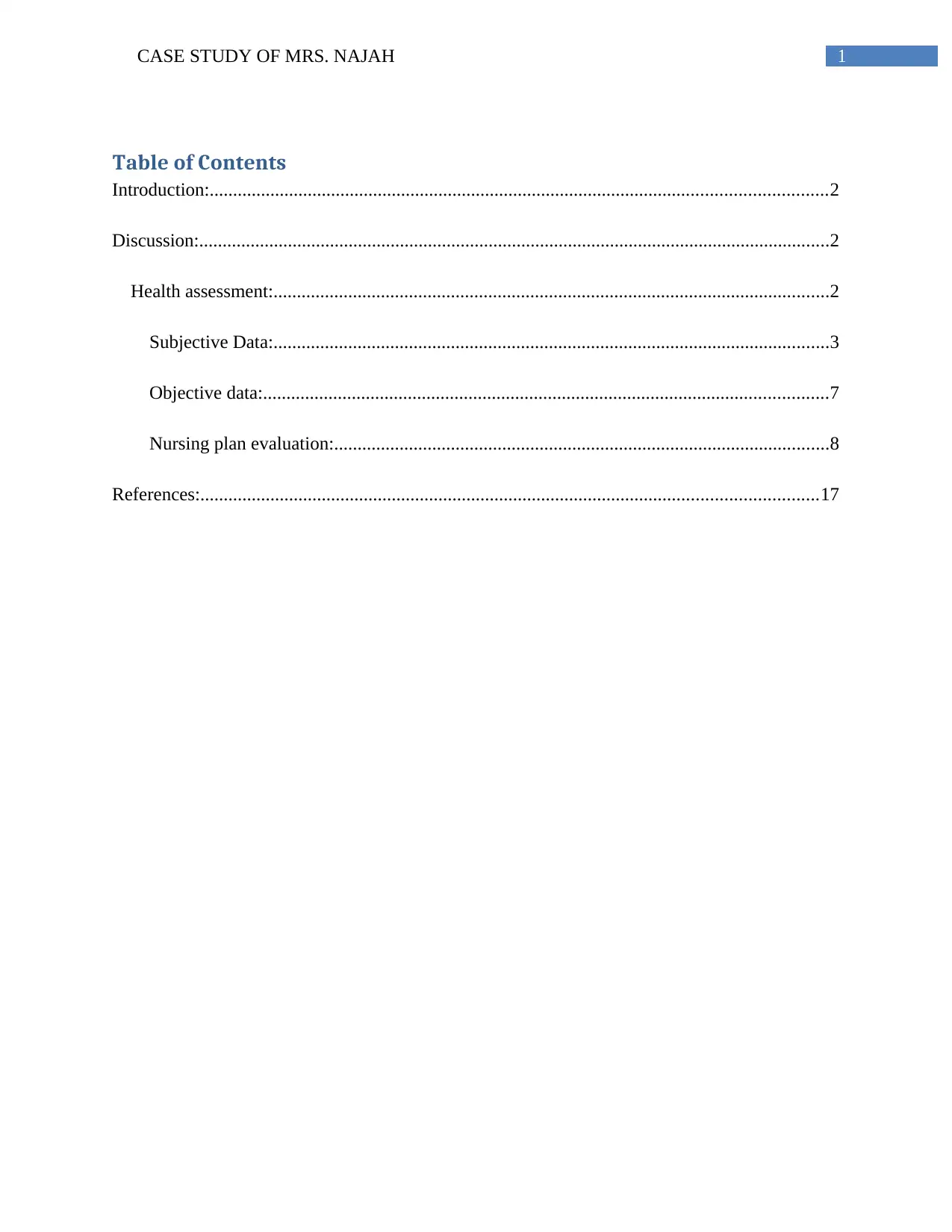
1CASE STUDY OF MRS. NAJAH
Table of Contents
Introduction:....................................................................................................................................2
Discussion:.......................................................................................................................................2
Health assessment:.......................................................................................................................2
Subjective Data:.......................................................................................................................3
Objective data:.........................................................................................................................7
Nursing plan evaluation:..........................................................................................................8
References:....................................................................................................................................17
Table of Contents
Introduction:....................................................................................................................................2
Discussion:.......................................................................................................................................2
Health assessment:.......................................................................................................................2
Subjective Data:.......................................................................................................................3
Objective data:.........................................................................................................................7
Nursing plan evaluation:..........................................................................................................8
References:....................................................................................................................................17
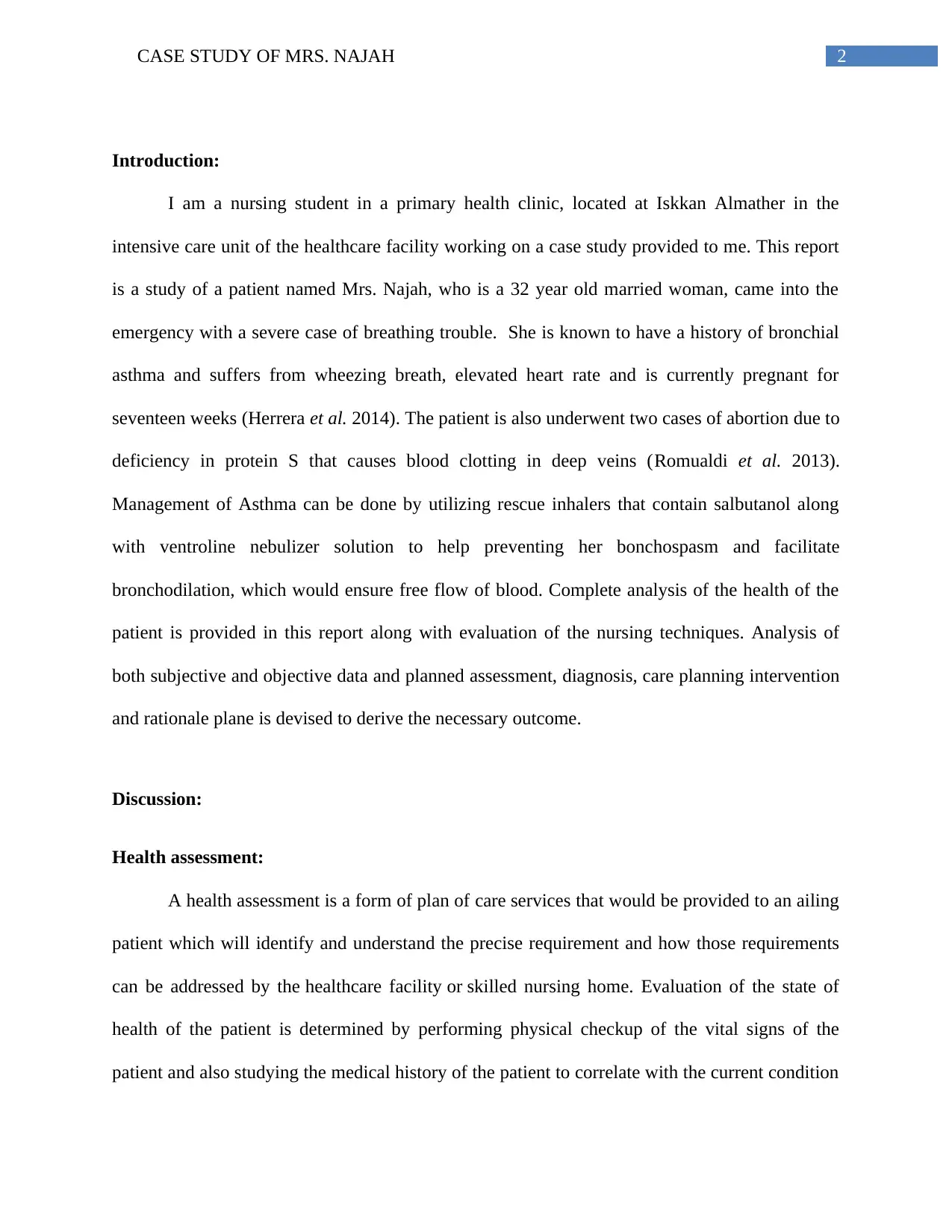
2CASE STUDY OF MRS. NAJAH
Introduction:
I am a nursing student in a primary health clinic, located at Iskkan Almather in the
intensive care unit of the healthcare facility working on a case study provided to me. This report
is a study of a patient named Mrs. Najah, who is a 32 year old married woman, came into the
emergency with a severe case of breathing trouble. She is known to have a history of bronchial
asthma and suffers from wheezing breath, elevated heart rate and is currently pregnant for
seventeen weeks (Herrera et al. 2014). The patient is also underwent two cases of abortion due to
deficiency in protein S that causes blood clotting in deep veins (Romualdi et al. 2013).
Management of Asthma can be done by utilizing rescue inhalers that contain salbutanol along
with ventroline nebulizer solution to help preventing her bonchospasm and facilitate
bronchodilation, which would ensure free flow of blood. Complete analysis of the health of the
patient is provided in this report along with evaluation of the nursing techniques. Analysis of
both subjective and objective data and planned assessment, diagnosis, care planning intervention
and rationale plane is devised to derive the necessary outcome.
Discussion:
Health assessment:
A health assessment is a form of plan of care services that would be provided to an ailing
patient which will identify and understand the precise requirement and how those requirements
can be addressed by the healthcare facility or skilled nursing home. Evaluation of the state of
health of the patient is determined by performing physical checkup of the vital signs of the
patient and also studying the medical history of the patient to correlate with the current condition
Introduction:
I am a nursing student in a primary health clinic, located at Iskkan Almather in the
intensive care unit of the healthcare facility working on a case study provided to me. This report
is a study of a patient named Mrs. Najah, who is a 32 year old married woman, came into the
emergency with a severe case of breathing trouble. She is known to have a history of bronchial
asthma and suffers from wheezing breath, elevated heart rate and is currently pregnant for
seventeen weeks (Herrera et al. 2014). The patient is also underwent two cases of abortion due to
deficiency in protein S that causes blood clotting in deep veins (Romualdi et al. 2013).
Management of Asthma can be done by utilizing rescue inhalers that contain salbutanol along
with ventroline nebulizer solution to help preventing her bonchospasm and facilitate
bronchodilation, which would ensure free flow of blood. Complete analysis of the health of the
patient is provided in this report along with evaluation of the nursing techniques. Analysis of
both subjective and objective data and planned assessment, diagnosis, care planning intervention
and rationale plane is devised to derive the necessary outcome.
Discussion:
Health assessment:
A health assessment is a form of plan of care services that would be provided to an ailing
patient which will identify and understand the precise requirement and how those requirements
can be addressed by the healthcare facility or skilled nursing home. Evaluation of the state of
health of the patient is determined by performing physical checkup of the vital signs of the
patient and also studying the medical history of the patient to correlate with the current condition
⊘ This is a preview!⊘
Do you want full access?
Subscribe today to unlock all pages.

Trusted by 1+ million students worldwide
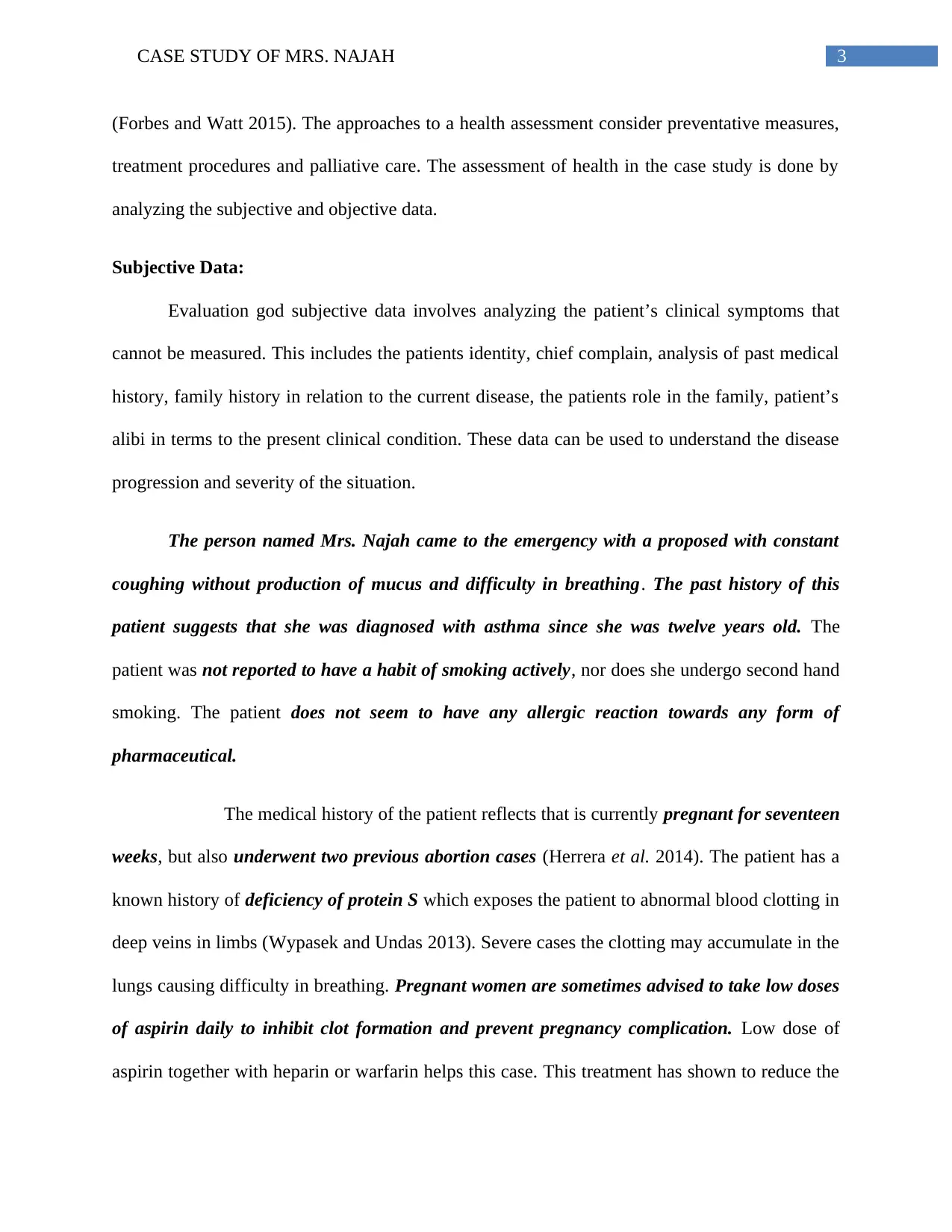
3CASE STUDY OF MRS. NAJAH
(Forbes and Watt 2015). The approaches to a health assessment consider preventative measures,
treatment procedures and palliative care. The assessment of health in the case study is done by
analyzing the subjective and objective data.
Subjective Data:
Evaluation god subjective data involves analyzing the patient’s clinical symptoms that
cannot be measured. This includes the patients identity, chief complain, analysis of past medical
history, family history in relation to the current disease, the patients role in the family, patient’s
alibi in terms to the present clinical condition. These data can be used to understand the disease
progression and severity of the situation.
The person named Mrs. Najah came to the emergency with a proposed with constant
coughing without production of mucus and difficulty in breathing. The past history of this
patient suggests that she was diagnosed with asthma since she was twelve years old. The
patient was not reported to have a habit of smoking actively, nor does she undergo second hand
smoking. The patient does not seem to have any allergic reaction towards any form of
pharmaceutical.
The medical history of the patient reflects that is currently pregnant for seventeen
weeks, but also underwent two previous abortion cases (Herrera et al. 2014). The patient has a
known history of deficiency of protein S which exposes the patient to abnormal blood clotting in
deep veins in limbs (Wypasek and Undas 2013). Severe cases the clotting may accumulate in the
lungs causing difficulty in breathing. Pregnant women are sometimes advised to take low doses
of aspirin daily to inhibit clot formation and prevent pregnancy complication. Low dose of
aspirin together with heparin or warfarin helps this case. This treatment has shown to reduce the
(Forbes and Watt 2015). The approaches to a health assessment consider preventative measures,
treatment procedures and palliative care. The assessment of health in the case study is done by
analyzing the subjective and objective data.
Subjective Data:
Evaluation god subjective data involves analyzing the patient’s clinical symptoms that
cannot be measured. This includes the patients identity, chief complain, analysis of past medical
history, family history in relation to the current disease, the patients role in the family, patient’s
alibi in terms to the present clinical condition. These data can be used to understand the disease
progression and severity of the situation.
The person named Mrs. Najah came to the emergency with a proposed with constant
coughing without production of mucus and difficulty in breathing. The past history of this
patient suggests that she was diagnosed with asthma since she was twelve years old. The
patient was not reported to have a habit of smoking actively, nor does she undergo second hand
smoking. The patient does not seem to have any allergic reaction towards any form of
pharmaceutical.
The medical history of the patient reflects that is currently pregnant for seventeen
weeks, but also underwent two previous abortion cases (Herrera et al. 2014). The patient has a
known history of deficiency of protein S which exposes the patient to abnormal blood clotting in
deep veins in limbs (Wypasek and Undas 2013). Severe cases the clotting may accumulate in the
lungs causing difficulty in breathing. Pregnant women are sometimes advised to take low doses
of aspirin daily to inhibit clot formation and prevent pregnancy complication. Low dose of
aspirin together with heparin or warfarin helps this case. This treatment has shown to reduce the
Paraphrase This Document
Need a fresh take? Get an instant paraphrase of this document with our AI Paraphraser
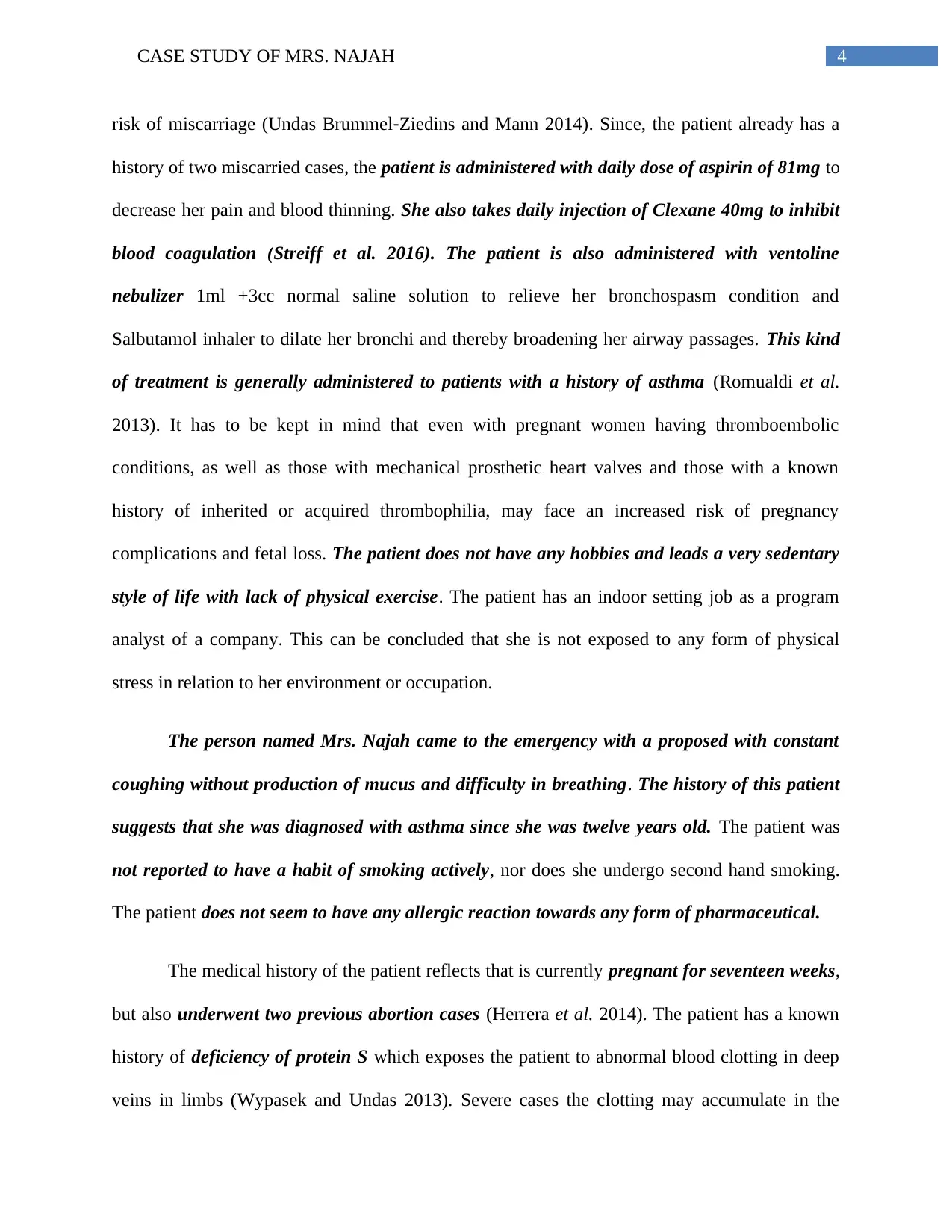
4CASE STUDY OF MRS. NAJAH
risk of miscarriage (Undas Brummel‐Ziedins and Mann 2014). Since, the patient already has a
history of two miscarried cases, the patient is administered with daily dose of aspirin of 81mg to
decrease her pain and blood thinning. She also takes daily injection of Clexane 40mg to inhibit
blood coagulation (Streiff et al. 2016). The patient is also administered with ventoline
nebulizer 1ml +3cc normal saline solution to relieve her bronchospasm condition and
Salbutamol inhaler to dilate her bronchi and thereby broadening her airway passages. This kind
of treatment is generally administered to patients with a history of asthma (Romualdi et al.
2013). It has to be kept in mind that even with pregnant women having thromboembolic
conditions, as well as those with mechanical prosthetic heart valves and those with a known
history of inherited or acquired thrombophilia, may face an increased risk of pregnancy
complications and fetal loss. The patient does not have any hobbies and leads a very sedentary
style of life with lack of physical exercise. The patient has an indoor setting job as a program
analyst of a company. This can be concluded that she is not exposed to any form of physical
stress in relation to her environment or occupation.
The person named Mrs. Najah came to the emergency with a proposed with constant
coughing without production of mucus and difficulty in breathing. The history of this patient
suggests that she was diagnosed with asthma since she was twelve years old. The patient was
not reported to have a habit of smoking actively, nor does she undergo second hand smoking.
The patient does not seem to have any allergic reaction towards any form of pharmaceutical.
The medical history of the patient reflects that is currently pregnant for seventeen weeks,
but also underwent two previous abortion cases (Herrera et al. 2014). The patient has a known
history of deficiency of protein S which exposes the patient to abnormal blood clotting in deep
veins in limbs (Wypasek and Undas 2013). Severe cases the clotting may accumulate in the
risk of miscarriage (Undas Brummel‐Ziedins and Mann 2014). Since, the patient already has a
history of two miscarried cases, the patient is administered with daily dose of aspirin of 81mg to
decrease her pain and blood thinning. She also takes daily injection of Clexane 40mg to inhibit
blood coagulation (Streiff et al. 2016). The patient is also administered with ventoline
nebulizer 1ml +3cc normal saline solution to relieve her bronchospasm condition and
Salbutamol inhaler to dilate her bronchi and thereby broadening her airway passages. This kind
of treatment is generally administered to patients with a history of asthma (Romualdi et al.
2013). It has to be kept in mind that even with pregnant women having thromboembolic
conditions, as well as those with mechanical prosthetic heart valves and those with a known
history of inherited or acquired thrombophilia, may face an increased risk of pregnancy
complications and fetal loss. The patient does not have any hobbies and leads a very sedentary
style of life with lack of physical exercise. The patient has an indoor setting job as a program
analyst of a company. This can be concluded that she is not exposed to any form of physical
stress in relation to her environment or occupation.
The person named Mrs. Najah came to the emergency with a proposed with constant
coughing without production of mucus and difficulty in breathing. The history of this patient
suggests that she was diagnosed with asthma since she was twelve years old. The patient was
not reported to have a habit of smoking actively, nor does she undergo second hand smoking.
The patient does not seem to have any allergic reaction towards any form of pharmaceutical.
The medical history of the patient reflects that is currently pregnant for seventeen weeks,
but also underwent two previous abortion cases (Herrera et al. 2014). The patient has a known
history of deficiency of protein S which exposes the patient to abnormal blood clotting in deep
veins in limbs (Wypasek and Undas 2013). Severe cases the clotting may accumulate in the
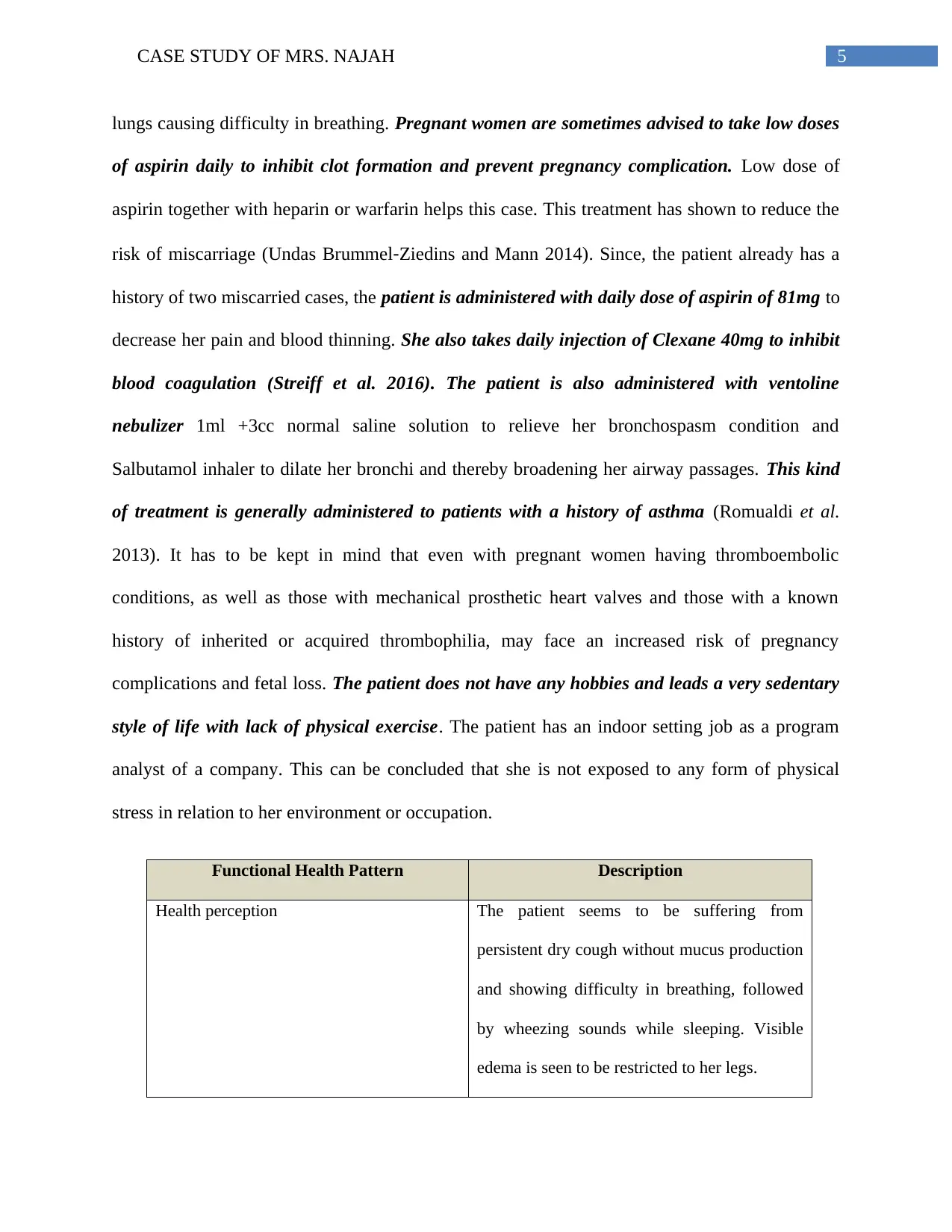
5CASE STUDY OF MRS. NAJAH
lungs causing difficulty in breathing. Pregnant women are sometimes advised to take low doses
of aspirin daily to inhibit clot formation and prevent pregnancy complication. Low dose of
aspirin together with heparin or warfarin helps this case. This treatment has shown to reduce the
risk of miscarriage (Undas Brummel‐Ziedins and Mann 2014). Since, the patient already has a
history of two miscarried cases, the patient is administered with daily dose of aspirin of 81mg to
decrease her pain and blood thinning. She also takes daily injection of Clexane 40mg to inhibit
blood coagulation (Streiff et al. 2016). The patient is also administered with ventoline
nebulizer 1ml +3cc normal saline solution to relieve her bronchospasm condition and
Salbutamol inhaler to dilate her bronchi and thereby broadening her airway passages. This kind
of treatment is generally administered to patients with a history of asthma (Romualdi et al.
2013). It has to be kept in mind that even with pregnant women having thromboembolic
conditions, as well as those with mechanical prosthetic heart valves and those with a known
history of inherited or acquired thrombophilia, may face an increased risk of pregnancy
complications and fetal loss. The patient does not have any hobbies and leads a very sedentary
style of life with lack of physical exercise. The patient has an indoor setting job as a program
analyst of a company. This can be concluded that she is not exposed to any form of physical
stress in relation to her environment or occupation.
Functional Health Pattern Description
Health perception The patient seems to be suffering from
persistent dry cough without mucus production
and showing difficulty in breathing, followed
by wheezing sounds while sleeping. Visible
edema is seen to be restricted to her legs.
lungs causing difficulty in breathing. Pregnant women are sometimes advised to take low doses
of aspirin daily to inhibit clot formation and prevent pregnancy complication. Low dose of
aspirin together with heparin or warfarin helps this case. This treatment has shown to reduce the
risk of miscarriage (Undas Brummel‐Ziedins and Mann 2014). Since, the patient already has a
history of two miscarried cases, the patient is administered with daily dose of aspirin of 81mg to
decrease her pain and blood thinning. She also takes daily injection of Clexane 40mg to inhibit
blood coagulation (Streiff et al. 2016). The patient is also administered with ventoline
nebulizer 1ml +3cc normal saline solution to relieve her bronchospasm condition and
Salbutamol inhaler to dilate her bronchi and thereby broadening her airway passages. This kind
of treatment is generally administered to patients with a history of asthma (Romualdi et al.
2013). It has to be kept in mind that even with pregnant women having thromboembolic
conditions, as well as those with mechanical prosthetic heart valves and those with a known
history of inherited or acquired thrombophilia, may face an increased risk of pregnancy
complications and fetal loss. The patient does not have any hobbies and leads a very sedentary
style of life with lack of physical exercise. The patient has an indoor setting job as a program
analyst of a company. This can be concluded that she is not exposed to any form of physical
stress in relation to her environment or occupation.
Functional Health Pattern Description
Health perception The patient seems to be suffering from
persistent dry cough without mucus production
and showing difficulty in breathing, followed
by wheezing sounds while sleeping. Visible
edema is seen to be restricted to her legs.
⊘ This is a preview!⊘
Do you want full access?
Subscribe today to unlock all pages.

Trusted by 1+ million students worldwide
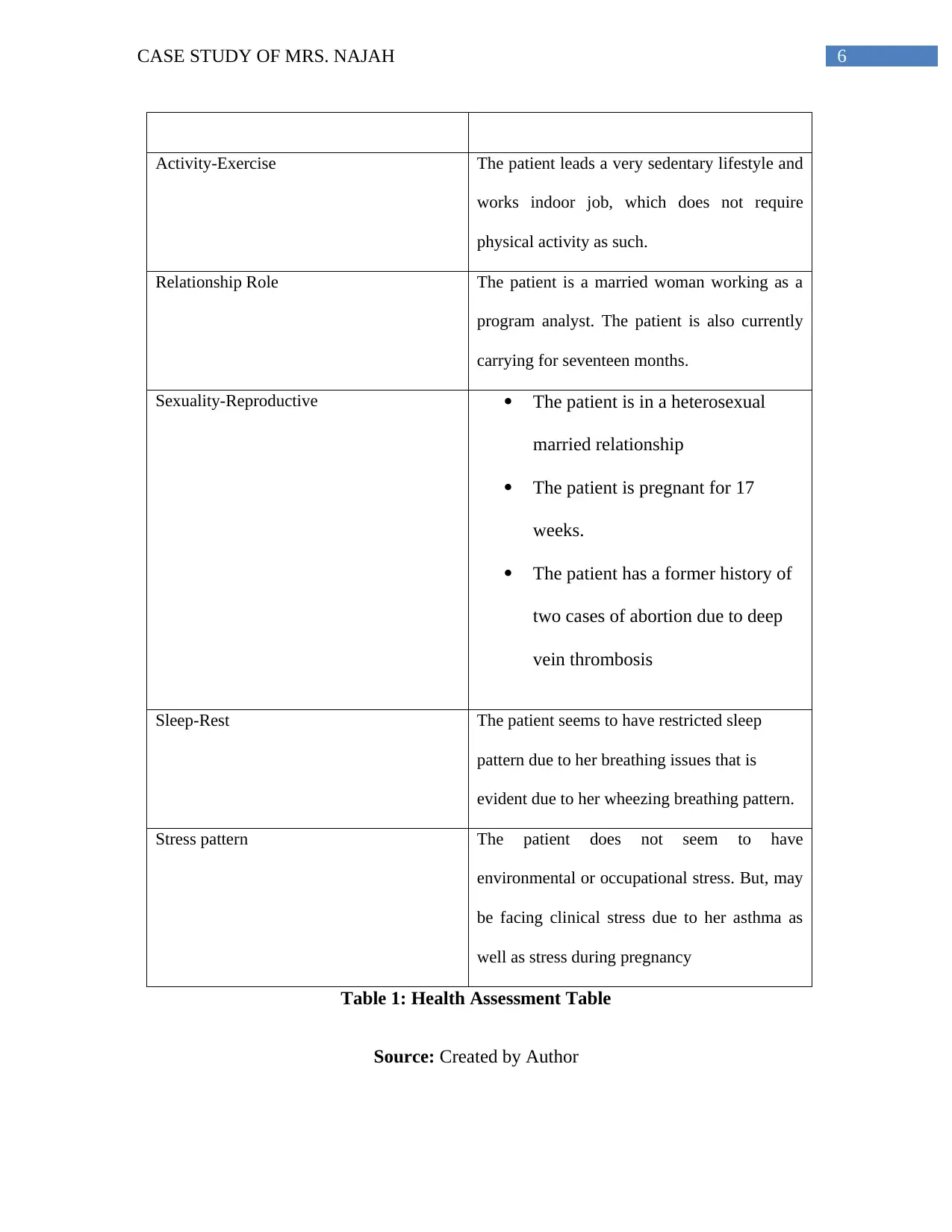
6CASE STUDY OF MRS. NAJAH
Activity-Exercise The patient leads a very sedentary lifestyle and
works indoor job, which does not require
physical activity as such.
Relationship Role The patient is a married woman working as a
program analyst. The patient is also currently
carrying for seventeen months.
Sexuality-Reproductive The patient is in a heterosexual
married relationship
The patient is pregnant for 17
weeks.
The patient has a former history of
two cases of abortion due to deep
vein thrombosis
Sleep-Rest The patient seems to have restricted sleep
pattern due to her breathing issues that is
evident due to her wheezing breathing pattern.
Stress pattern The patient does not seem to have
environmental or occupational stress. But, may
be facing clinical stress due to her asthma as
well as stress during pregnancy
Table 1: Health Assessment Table
Source: Created by Author
Activity-Exercise The patient leads a very sedentary lifestyle and
works indoor job, which does not require
physical activity as such.
Relationship Role The patient is a married woman working as a
program analyst. The patient is also currently
carrying for seventeen months.
Sexuality-Reproductive The patient is in a heterosexual
married relationship
The patient is pregnant for 17
weeks.
The patient has a former history of
two cases of abortion due to deep
vein thrombosis
Sleep-Rest The patient seems to have restricted sleep
pattern due to her breathing issues that is
evident due to her wheezing breathing pattern.
Stress pattern The patient does not seem to have
environmental or occupational stress. But, may
be facing clinical stress due to her asthma as
well as stress during pregnancy
Table 1: Health Assessment Table
Source: Created by Author
Paraphrase This Document
Need a fresh take? Get an instant paraphrase of this document with our AI Paraphraser
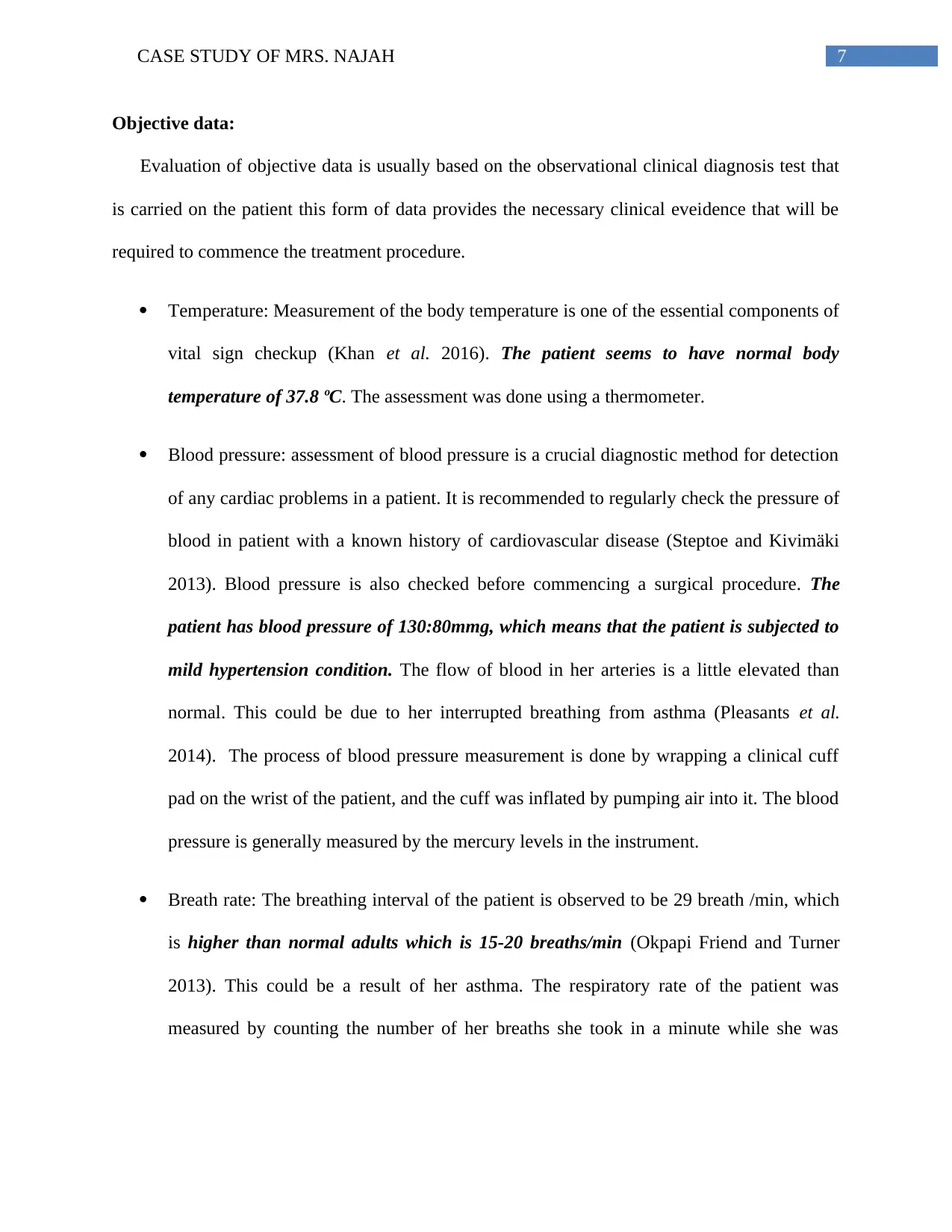
7CASE STUDY OF MRS. NAJAH
Objective data:
Evaluation of objective data is usually based on the observational clinical diagnosis test that
is carried on the patient this form of data provides the necessary clinical eveidence that will be
required to commence the treatment procedure.
Temperature: Measurement of the body temperature is one of the essential components of
vital sign checkup (Khan et al. 2016). The patient seems to have normal body
temperature of 37.8 ºC. The assessment was done using a thermometer.
Blood pressure: assessment of blood pressure is a crucial diagnostic method for detection
of any cardiac problems in a patient. It is recommended to regularly check the pressure of
blood in patient with a known history of cardiovascular disease (Steptoe and Kivimäki
2013). Blood pressure is also checked before commencing a surgical procedure. The
patient has blood pressure of 130:80mmg, which means that the patient is subjected to
mild hypertension condition. The flow of blood in her arteries is a little elevated than
normal. This could be due to her interrupted breathing from asthma (Pleasants et al.
2014). The process of blood pressure measurement is done by wrapping a clinical cuff
pad on the wrist of the patient, and the cuff was inflated by pumping air into it. The blood
pressure is generally measured by the mercury levels in the instrument.
Breath rate: The breathing interval of the patient is observed to be 29 breath /min, which
is higher than normal adults which is 15-20 breaths/min (Okpapi Friend and Turner
2013). This could be a result of her asthma. The respiratory rate of the patient was
measured by counting the number of her breaths she took in a minute while she was
Objective data:
Evaluation of objective data is usually based on the observational clinical diagnosis test that
is carried on the patient this form of data provides the necessary clinical eveidence that will be
required to commence the treatment procedure.
Temperature: Measurement of the body temperature is one of the essential components of
vital sign checkup (Khan et al. 2016). The patient seems to have normal body
temperature of 37.8 ºC. The assessment was done using a thermometer.
Blood pressure: assessment of blood pressure is a crucial diagnostic method for detection
of any cardiac problems in a patient. It is recommended to regularly check the pressure of
blood in patient with a known history of cardiovascular disease (Steptoe and Kivimäki
2013). Blood pressure is also checked before commencing a surgical procedure. The
patient has blood pressure of 130:80mmg, which means that the patient is subjected to
mild hypertension condition. The flow of blood in her arteries is a little elevated than
normal. This could be due to her interrupted breathing from asthma (Pleasants et al.
2014). The process of blood pressure measurement is done by wrapping a clinical cuff
pad on the wrist of the patient, and the cuff was inflated by pumping air into it. The blood
pressure is generally measured by the mercury levels in the instrument.
Breath rate: The breathing interval of the patient is observed to be 29 breath /min, which
is higher than normal adults which is 15-20 breaths/min (Okpapi Friend and Turner
2013). This could be a result of her asthma. The respiratory rate of the patient was
measured by counting the number of her breaths she took in a minute while she was
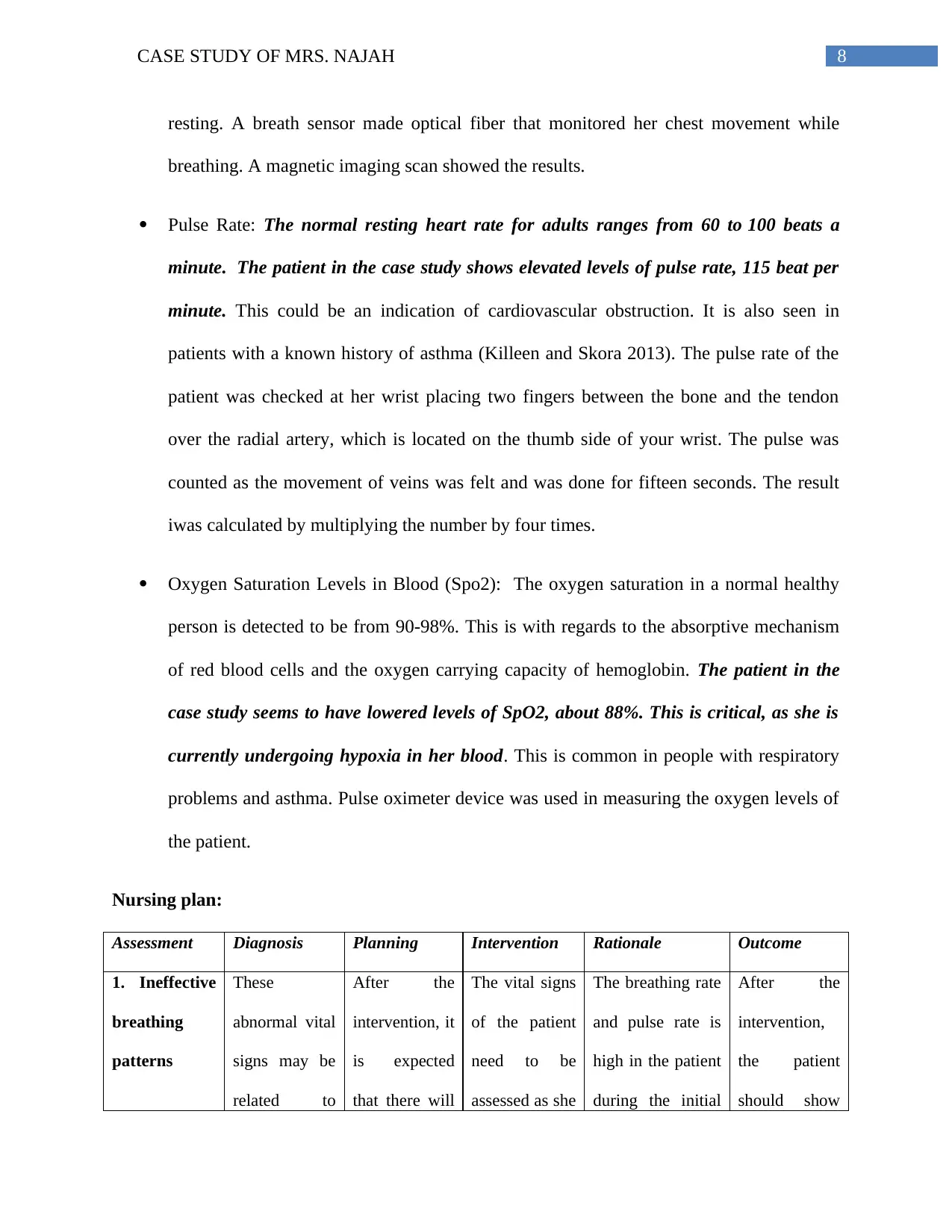
8CASE STUDY OF MRS. NAJAH
resting. A breath sensor made optical fiber that monitored her chest movement while
breathing. A magnetic imaging scan showed the results.
Pulse Rate: The normal resting heart rate for adults ranges from 60 to 100 beats a
minute. The patient in the case study shows elevated levels of pulse rate, 115 beat per
minute. This could be an indication of cardiovascular obstruction. It is also seen in
patients with a known history of asthma (Killeen and Skora 2013). The pulse rate of the
patient was checked at her wrist placing two fingers between the bone and the tendon
over the radial artery, which is located on the thumb side of your wrist. The pulse was
counted as the movement of veins was felt and was done for fifteen seconds. The result
iwas calculated by multiplying the number by four times.
Oxygen Saturation Levels in Blood (Spo2): The oxygen saturation in a normal healthy
person is detected to be from 90-98%. This is with regards to the absorptive mechanism
of red blood cells and the oxygen carrying capacity of hemoglobin. The patient in the
case study seems to have lowered levels of SpO2, about 88%. This is critical, as she is
currently undergoing hypoxia in her blood. This is common in people with respiratory
problems and asthma. Pulse oximeter device was used in measuring the oxygen levels of
the patient.
Nursing plan:
Assessment Diagnosis Planning Intervention Rationale Outcome
1. Ineffective
breathing
patterns
These
abnormal vital
signs may be
related to
After the
intervention, it
is expected
that there will
The vital signs
of the patient
need to be
assessed as she
The breathing rate
and pulse rate is
high in the patient
during the initial
After the
intervention,
the patient
should show
resting. A breath sensor made optical fiber that monitored her chest movement while
breathing. A magnetic imaging scan showed the results.
Pulse Rate: The normal resting heart rate for adults ranges from 60 to 100 beats a
minute. The patient in the case study shows elevated levels of pulse rate, 115 beat per
minute. This could be an indication of cardiovascular obstruction. It is also seen in
patients with a known history of asthma (Killeen and Skora 2013). The pulse rate of the
patient was checked at her wrist placing two fingers between the bone and the tendon
over the radial artery, which is located on the thumb side of your wrist. The pulse was
counted as the movement of veins was felt and was done for fifteen seconds. The result
iwas calculated by multiplying the number by four times.
Oxygen Saturation Levels in Blood (Spo2): The oxygen saturation in a normal healthy
person is detected to be from 90-98%. This is with regards to the absorptive mechanism
of red blood cells and the oxygen carrying capacity of hemoglobin. The patient in the
case study seems to have lowered levels of SpO2, about 88%. This is critical, as she is
currently undergoing hypoxia in her blood. This is common in people with respiratory
problems and asthma. Pulse oximeter device was used in measuring the oxygen levels of
the patient.
Nursing plan:
Assessment Diagnosis Planning Intervention Rationale Outcome
1. Ineffective
breathing
patterns
These
abnormal vital
signs may be
related to
After the
intervention, it
is expected
that there will
The vital signs
of the patient
need to be
assessed as she
The breathing rate
and pulse rate is
high in the patient
during the initial
After the
intervention,
the patient
should show
⊘ This is a preview!⊘
Do you want full access?
Subscribe today to unlock all pages.

Trusted by 1+ million students worldwide
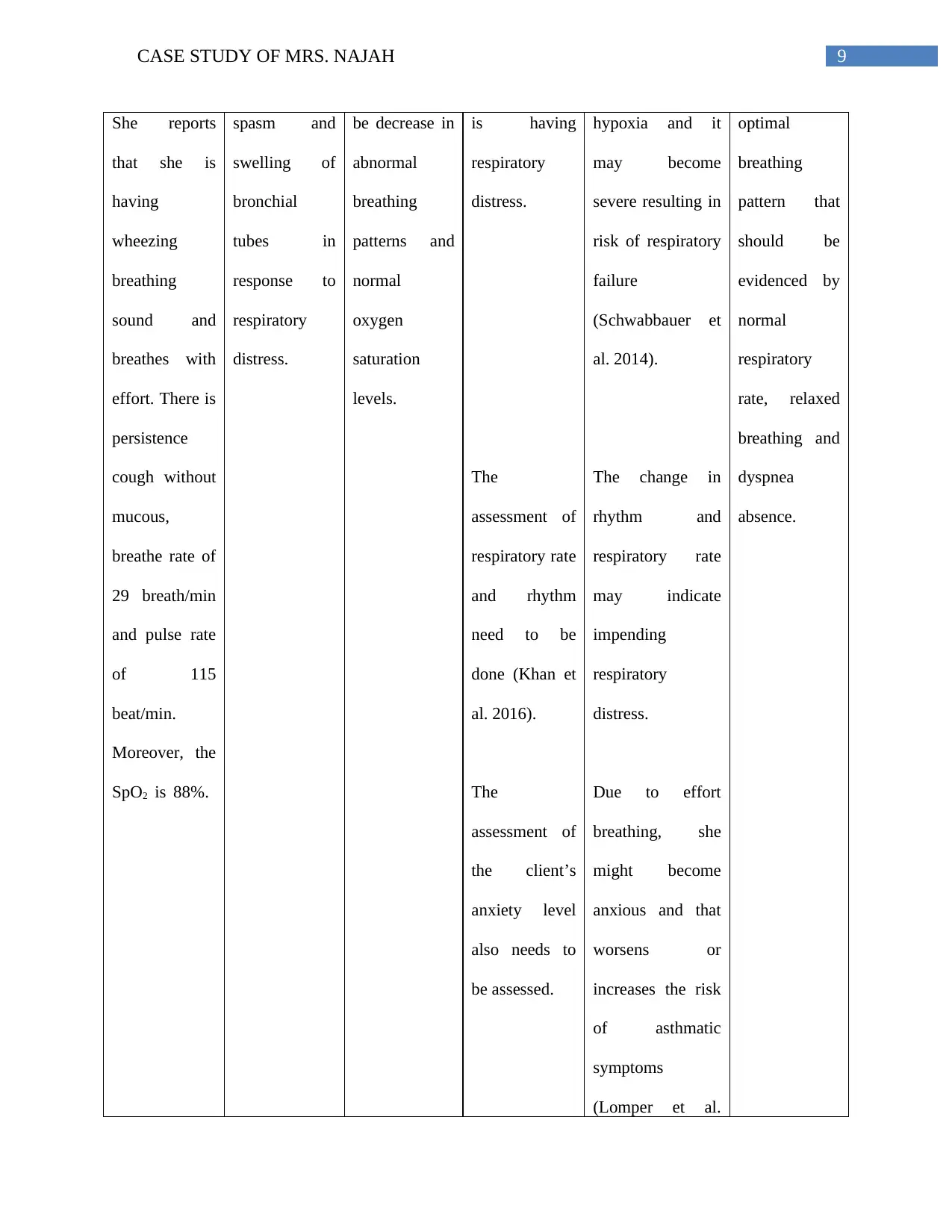
9CASE STUDY OF MRS. NAJAH
She reports
that she is
having
wheezing
breathing
sound and
breathes with
effort. There is
persistence
cough without
mucous,
breathe rate of
29 breath/min
and pulse rate
of 115
beat/min.
Moreover, the
SpO2 is 88%.
spasm and
swelling of
bronchial
tubes in
response to
respiratory
distress.
be decrease in
abnormal
breathing
patterns and
normal
oxygen
saturation
levels.
is having
respiratory
distress.
The
assessment of
respiratory rate
and rhythm
need to be
done (Khan et
al. 2016).
The
assessment of
the client’s
anxiety level
also needs to
be assessed.
hypoxia and it
may become
severe resulting in
risk of respiratory
failure
(Schwabbauer et
al. 2014).
The change in
rhythm and
respiratory rate
may indicate
impending
respiratory
distress.
Due to effort
breathing, she
might become
anxious and that
worsens or
increases the risk
of asthmatic
symptoms
(Lomper et al.
optimal
breathing
pattern that
should be
evidenced by
normal
respiratory
rate, relaxed
breathing and
dyspnea
absence.
She reports
that she is
having
wheezing
breathing
sound and
breathes with
effort. There is
persistence
cough without
mucous,
breathe rate of
29 breath/min
and pulse rate
of 115
beat/min.
Moreover, the
SpO2 is 88%.
spasm and
swelling of
bronchial
tubes in
response to
respiratory
distress.
be decrease in
abnormal
breathing
patterns and
normal
oxygen
saturation
levels.
is having
respiratory
distress.
The
assessment of
respiratory rate
and rhythm
need to be
done (Khan et
al. 2016).
The
assessment of
the client’s
anxiety level
also needs to
be assessed.
hypoxia and it
may become
severe resulting in
risk of respiratory
failure
(Schwabbauer et
al. 2014).
The change in
rhythm and
respiratory rate
may indicate
impending
respiratory
distress.
Due to effort
breathing, she
might become
anxious and that
worsens or
increases the risk
of asthmatic
symptoms
(Lomper et al.
optimal
breathing
pattern that
should be
evidenced by
normal
respiratory
rate, relaxed
breathing and
dyspnea
absence.
Paraphrase This Document
Need a fresh take? Get an instant paraphrase of this document with our AI Paraphraser
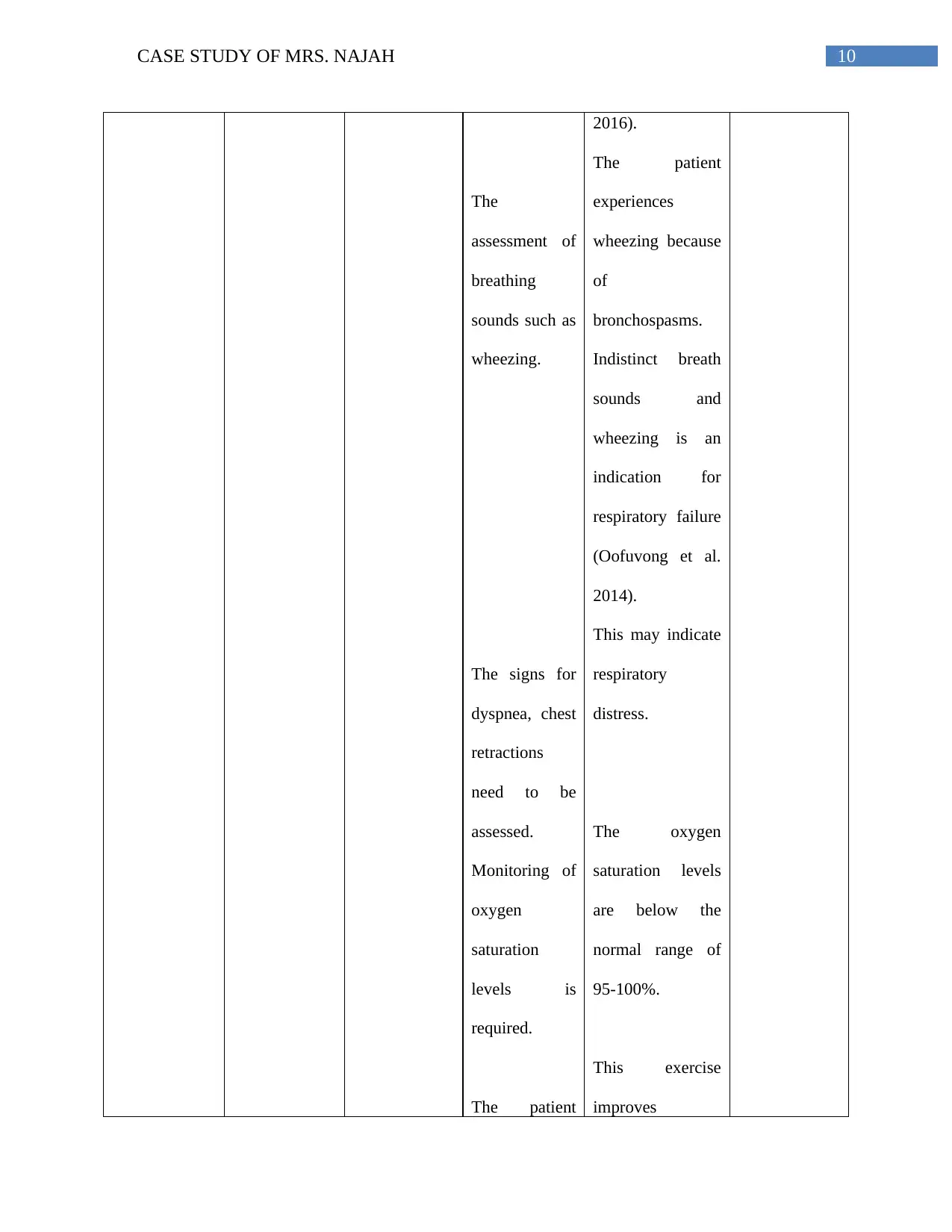
10CASE STUDY OF MRS. NAJAH
The
assessment of
breathing
sounds such as
wheezing.
The signs for
dyspnea, chest
retractions
need to be
assessed.
Monitoring of
oxygen
saturation
levels is
required.
The patient
2016).
The patient
experiences
wheezing because
of
bronchospasms.
Indistinct breath
sounds and
wheezing is an
indication for
respiratory failure
(Oofuvong et al.
2014).
This may indicate
respiratory
distress.
The oxygen
saturation levels
are below the
normal range of
95-100%.
This exercise
improves
The
assessment of
breathing
sounds such as
wheezing.
The signs for
dyspnea, chest
retractions
need to be
assessed.
Monitoring of
oxygen
saturation
levels is
required.
The patient
2016).
The patient
experiences
wheezing because
of
bronchospasms.
Indistinct breath
sounds and
wheezing is an
indication for
respiratory failure
(Oofuvong et al.
2014).
This may indicate
respiratory
distress.
The oxygen
saturation levels
are below the
normal range of
95-100%.
This exercise
improves
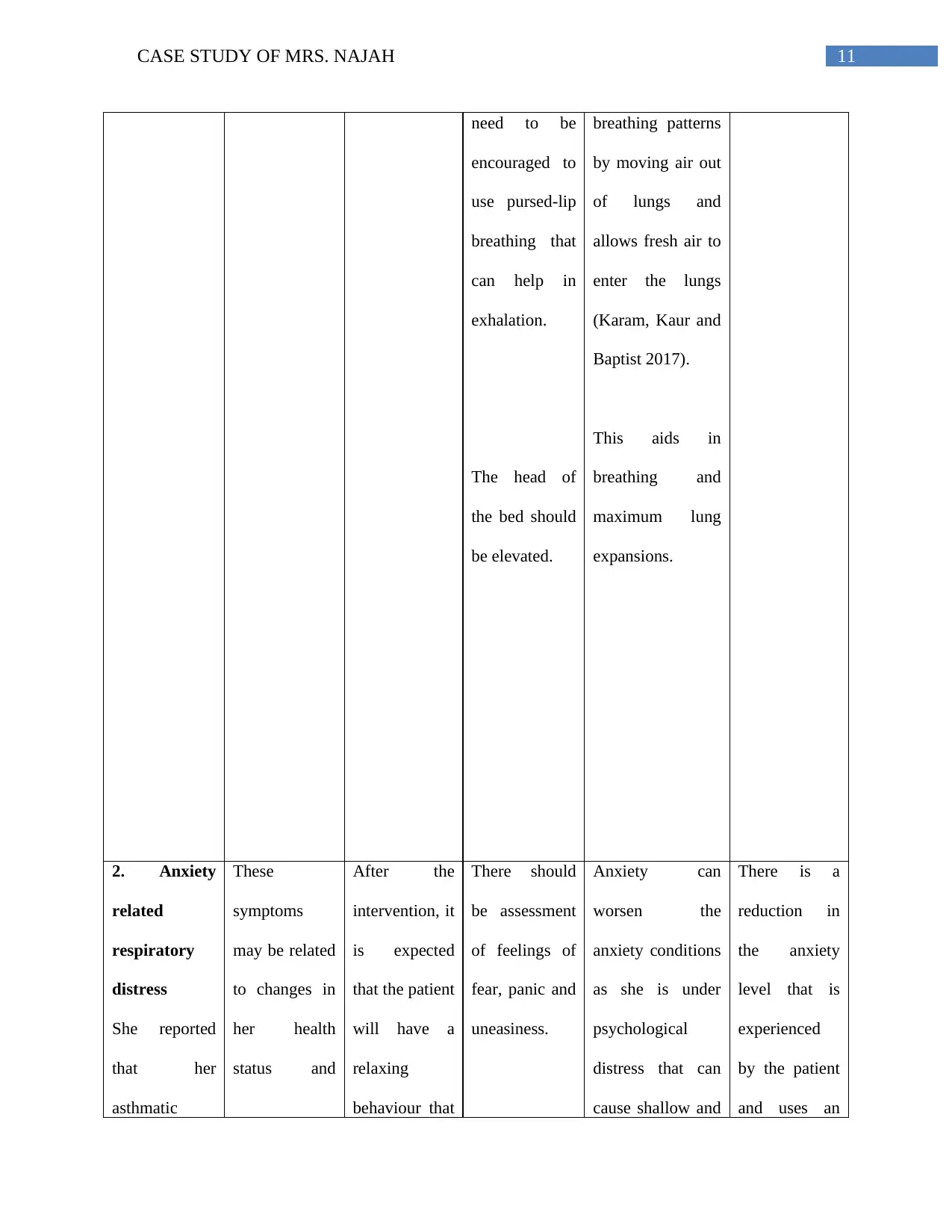
11CASE STUDY OF MRS. NAJAH
need to be
encouraged to
use pursed-lip
breathing that
can help in
exhalation.
The head of
the bed should
be elevated.
breathing patterns
by moving air out
of lungs and
allows fresh air to
enter the lungs
(Karam, Kaur and
Baptist 2017).
This aids in
breathing and
maximum lung
expansions.
2. Anxiety
related
respiratory
distress
She reported
that her
asthmatic
These
symptoms
may be related
to changes in
her health
status and
After the
intervention, it
is expected
that the patient
will have a
relaxing
behaviour that
There should
be assessment
of feelings of
fear, panic and
uneasiness.
Anxiety can
worsen the
anxiety conditions
as she is under
psychological
distress that can
cause shallow and
There is a
reduction in
the anxiety
level that is
experienced
by the patient
and uses an
need to be
encouraged to
use pursed-lip
breathing that
can help in
exhalation.
The head of
the bed should
be elevated.
breathing patterns
by moving air out
of lungs and
allows fresh air to
enter the lungs
(Karam, Kaur and
Baptist 2017).
This aids in
breathing and
maximum lung
expansions.
2. Anxiety
related
respiratory
distress
She reported
that her
asthmatic
These
symptoms
may be related
to changes in
her health
status and
After the
intervention, it
is expected
that the patient
will have a
relaxing
behaviour that
There should
be assessment
of feelings of
fear, panic and
uneasiness.
Anxiety can
worsen the
anxiety conditions
as she is under
psychological
distress that can
cause shallow and
There is a
reduction in
the anxiety
level that is
experienced
by the patient
and uses an
⊘ This is a preview!⊘
Do you want full access?
Subscribe today to unlock all pages.

Trusted by 1+ million students worldwide
1 out of 17
Related Documents
Your All-in-One AI-Powered Toolkit for Academic Success.
+13062052269
info@desklib.com
Available 24*7 on WhatsApp / Email
![[object Object]](/_next/static/media/star-bottom.7253800d.svg)
Unlock your academic potential
Copyright © 2020–2025 A2Z Services. All Rights Reserved. Developed and managed by ZUCOL.




